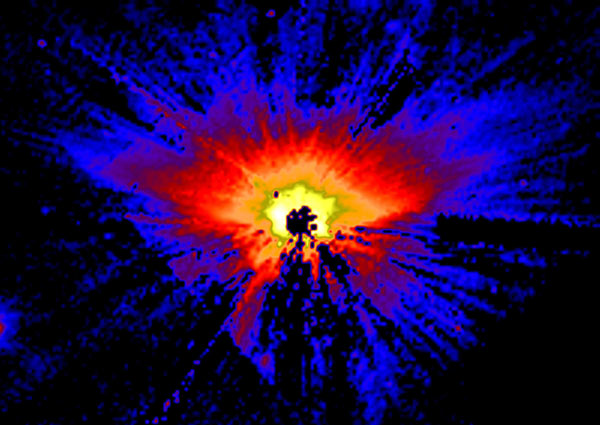Solar Systems Warped by Interstellar Wind

Close encounters with interstellar gas could have given thedust-filled disks of solar systems ? where planets are thought to form ? theodd shapes that some of them have taken on, a new study suggests.
Stars across the galaxy have disksof dusty debris generated by the collisions of small comet- andasteroid-like bodies orbiting each star.
Astronomers have noticed that many of these debris disks area bit wonky-looking, with lobes of dust sticking out in odd directions. Oneteam noticed just such an oddly-shaped disk while using the HubbleSpace Telescope to investigate the composition of the dust around the starHD 32297, which lies 340 light-years away from Earth in the constellationOrion.
John Debes of NASA's Goddard Space Flight Center in Greenbelt, Md., noticed that the interior portion of this star's dusty disk ? aregion comparable to the size of our own solar system ? was warped in a waythat was similar to other distant star systems.
Astronomers have previously attributed these warped shapesto the presence of undiscovered planets or past encounters with another star.But Debes and his colleagues used a model to show that the odd shapes aren'tlikely due to one of these exotic factors, but instead are likely caused by theinterstellar environment that the star and its attendant disk are movingthrough.
"It's important to consider the ecology of these debrisdisks before running to such conclusions, and this model explains a lot of theweirdly shaped disks we see," Debes said.
Interstellar breeze
Get the Space.com Newsletter
Breaking space news, the latest updates on rocket launches, skywatching events and more!
The model, described in the Sept. 1 issue of theAstrophysical Journal, simulates the movement of a star and its dust disk asthey orbit the center of the galaxy. As it moves through the galaxy, itencounters patches of thin gas clouds that litter the space between stars andcreate an effect like an interstellar breeze.
When the dust particles meet a relatively dense clump ofgas, the breeze, or flow, creates a drag force on the dust particles.
"The small particles slam into the flow, slow down andgradually bend from their original trajectories to follow it," Debes said.
The resulting shapes of the dust disk depend on theorientation of the star system to the gas cloud. If the system hits the cloudface-on, which seems to be the case for the star HD 61005 in the constellationPuppis, the disk bends gently away from the direction of motion. Fine dusttrails behind, forming a cylindrical wake.
If, on the other hand, the dust disk slices edgewise throughthe gas cloud, the headwind blows the fine dust away from the portion of thedisk inside the cloud, resulting in a lopsided disk.
"The drag from interstellar gas only affects theoutskirts of the disk, where the star?s gravity can?t really hold onto thematerial," said study team member Alycia Weinberger at the Carnegie Institutionof Washington, headquartered in Washington, D.C.
There was also evidence from previous studies thatinterstellar gas lurked in the region around HD 32297.
"The pieces came together to make me think that gasdrag was a good explanation for what was going on," Debes said.
The systems studied are about 100 million years old andresemble our own solar system shortly after the major planets formed. Althoughastronomers don?t know whether planets lurk within the disks of these systems,a better understanding of processes affecting a disk?s outer regions will shedlight on how ?ice giant? planets like Uranus and Neptune ? and the more distantswarm of small, icy bodies known as the Kuiper Belt ? formed within the solarsystem.
- The Wildest Weather in the Galaxy
- Galaxy Cluster's Ring Hints at Cosmic Shockwave
- Our Solar System is Squashed
Join our Space Forums to keep talking space on the latest missions, night sky and more! And if you have a news tip, correction or comment, let us know at: community@space.com.

Space.com is the premier source of space exploration, innovation and astronomy news, chronicling (and celebrating) humanity's ongoing expansion across the final frontier. Originally founded in 1999, Space.com is, and always has been, the passion of writers and editors who are space fans and also trained journalists. Our current news team consists of Editor-in-Chief Tariq Malik; Editor Hanneke Weitering, Senior Space Writer Mike Wall; Senior Writer Meghan Bartels; Senior Writer Chelsea Gohd, Senior Writer Tereza Pultarova and Staff Writer Alexander Cox, focusing on e-commerce. Senior Producer Steve Spaleta oversees our space videos, with Diana Whitcroft as our Social Media Editor.









